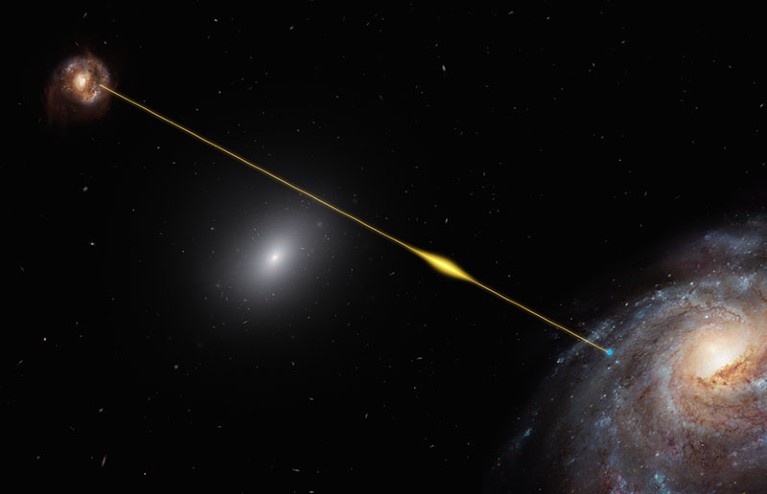The fast radio burst came from a galaxy, or galaxies, 8 billion light years from Earth.Credit: ESO/M. Kornmesser
Scientists have measured the most well-travelled fast radio burst to date. The bright, briefly detectable flash of energy has barrelled through the Universe for around eight billion years — almost half the age of the Universe — before hitting telescopes on Earth. It is also more than three times more powerful than expected, challenging current models.
The age of the fast radio burst was the biggest surprise to the researchers, who published their findings today in Science1. “We didn’t know whether fast radio bursts even existed that far back in time,” says study co-author Stuart Ryder, an astronomer at Macquarie University in Sydney, Australia.
In June 2022, Ryder and his colleagues detected the unusual fast radio burst — named FRB 20220610A — using the Australian Square Kilometre Array Pathfinder telescope in Western Australia. The researchers also used the European Southern Observatory’s Very Large Telescope in Chile and the W. M. Keck Observatory in Hawaii to pinpoint the galaxy where the fast radio burst originated.
A bumpy ride
As fast radio bursts travel through galaxies and in between them, they pass through hot gas, which causes their low-frequency radio waves to slow down more than those at higher frequencies, a phenomenon known as dispersion. This means that radio waves with distinct frequencies reach telescopes on Earth at slightly different times, enabling scientists to infer the presence of material that is too hot and spread out for other types of telescopes to detect directly, says Ryder. Fast radio bursts are therefore useful cosmological tools for analysing the Universe, because they allow scientists to detect and measure the matter that lies between galaxies that is currently invisible to us.
The signal produced by the new fast radio burst was more dispersed than most previous observations, suggesting that FRB 20220610A had a bumpy ride over its eight-billion-year-long journey. The unusually spread-out signal, plus the vast distance to its host galaxy, also confirmed what previous studies on nearby fast radio bursts had suggested: the further away they are, the more dispersed their signals will be when they reach Earth.
The fast radio burst was also powerful, emitting 3.5 times more energy than the maximum amount predicted by modelling. Such calculations should be tweaked to account for such extreme events, says Ryder. “We can now refine our estimate of what the distribution of burst energies is likely to be,” he says.
Kiyoshi Masui, an astrophysicist at the Massachusetts Institute of Technology in Cambridge, is not surprised that fast radio bursts persist over such distances. Scientists can learn a lot from these far-away pulses, Masui adds. “What is exciting is that we’re starting to see them and measure their properties,” he says. “As the sample of these distant bursts grows, they will tell us a lot about how the Universe evolved.”
A ‘galactic traffic accident’
As to what caused the burst, when the researchers zoomed in on FRB 20220610A’s galaxy of origin, they found it was made up of two or three bright clumps. This suggests that the blast might have emerged from a group of colliding galaxies rather than only one — a common event during the early days of the Universe. “Lots of galaxies were still assembling and having big galactic traffic accidents,” says Ryder.
The next step for Ryder and his team is to build a better understanding of the early Universe conditions that generated the powerful blast. “That’s something we’re definitely planning on exploring more,” he says.
